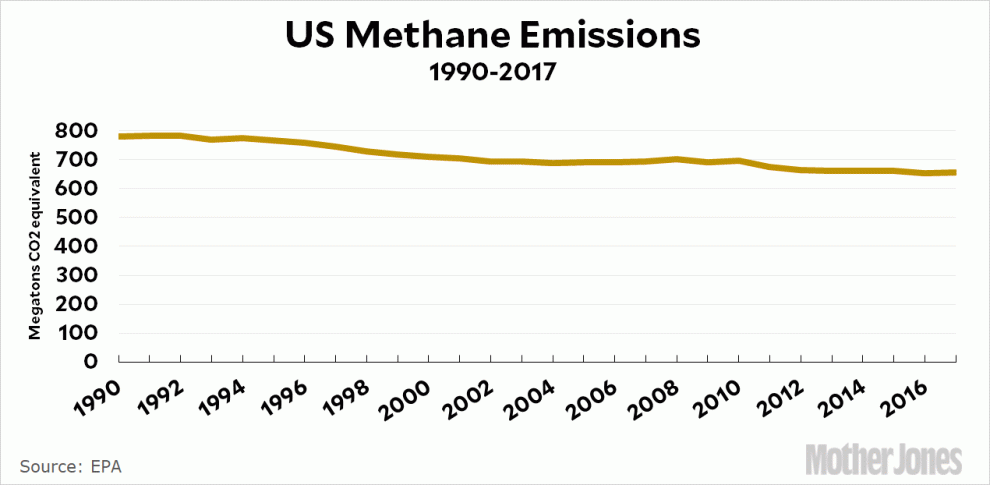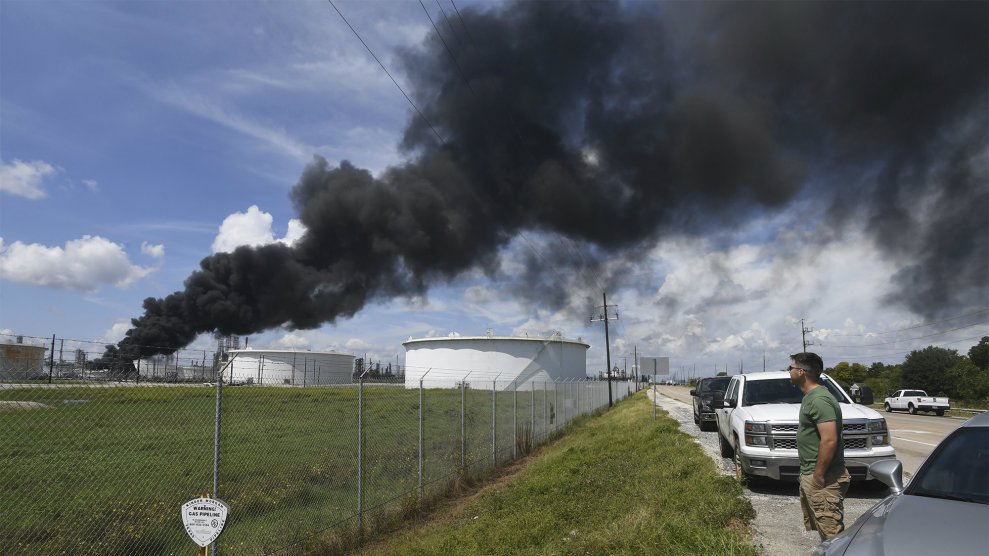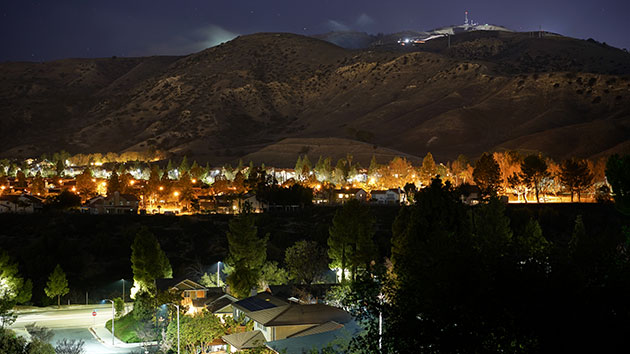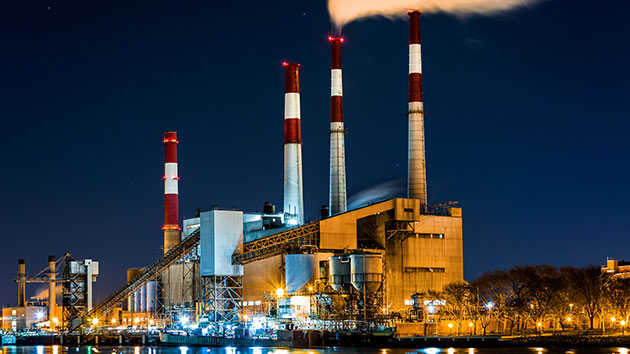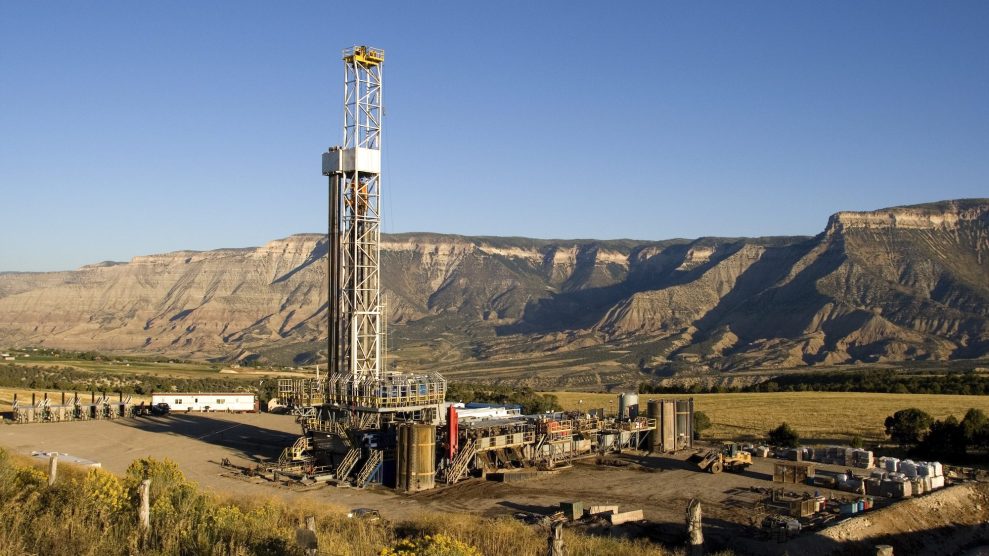
A rig drills for natural gas, framed by the cliffs of the Roan Plateau. Steven D Starr/Getty
This story was originally published by Yale Environment360 and appears here as part of the Climate Desk collaboration.
Driving along County Road 28 south of Platteville, the signs of Colorado’s oil and gas boom are everywhere you look. Storage tanks and wellheads dot the horizon. Bundles of pipe sit by the roadside, waiting to become pipelines. Drilling rigs loom behind enormous brown temporary sound barriers, a stone’s throw from homes and businesses.
This infrastructure is impossible to miss, but the methane that leaks from it can be much harder to detect. That’s why Greg Rieker and a colleague are out here on a cold, sun-drenched morning in the middle of the Denver-Julesburg Basin—one of the nation’s fracking hotspots—fine-tuning their frequency comb laser.
Standing atop a small trailer housing the $150,000 device, Rieker gestures across a grassy expanse toward a well pad half a mile away. “We’ve used this system to pinpoint a leak to about a 5-square-meter area,” he says. “It’s a question of, when leaks start, seeing them and sizing them properly so we can alert an operator there’s a problem. There are 20,000 wells out there. This is a Colorado-grown solution, using Colorado technology.”
Rieker is a professor of mechanical engineering at the University of Colorado Boulder and chief technology officer of LongPath Technologies, a startup that aims to provide oil and gas companies with a new method for detecting methane leaks from their operations. He is among a growing cadre of scientists and entrepreneurs working to develop and deploy novel technologies to address the growing issue of methane leaks across the fossil fuel supply chain.
In the United States, fugitive emissions from the oil and gas industry total an estimated 13 million metric tons per year, amounting to $2 billion in lost revenue; globally, the value of leaking gas is $30 billion.
Methane is a potent contributor to climate change, trapping 86 times as much heat as carbon dioxide over a 20-year period. It is responsible for about a quarter of total atmospheric warming to date, but it only lasts about a decade in the atmosphere, making reducing methane emissions a relatively fast-acting lever for climate action.In the United States, fugitive emissions from the oil and gas industry total an estimated 13 million metric tons per year, amounting to $2 billion in lost revenue; globally, the value of leaking gas is $30 billion.
That climate impact was the primary reason the US Environmental Protection Agency, under President Barack Obama, issued a rule in 2016 that set limits on methane emissions from new and modified oil and gas sources and required that operators monitor and repair leaking equipment. In August, President Trump’s EPA announced a replacement rule that would discard those requirements, effectively freeing companies from the obligation of regularly monitoring and plugging methane leaks from their operations.
Oil and gas giants like BP, ExxonMobil, and Shell have opposed the recent rollback, and pledged to continue with voluntary measures to cut their own methane emissions. Behind those pledges lies the fear that not tackling these leaks will undermine the industry-promoted narrative of natural gas as a “clean” fuel and invite tighter restrictions down the road.
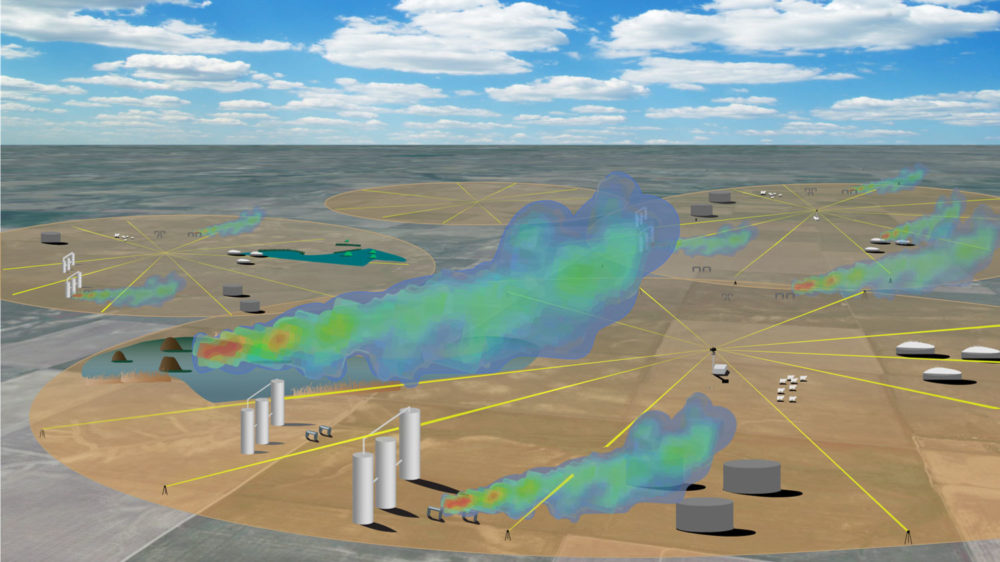
The frequency comb laser from LongPath Technologies sends beams of laser light across oil and gas fields, detecting gas clouds and measuring the size of leaks.
S. Sizemore / Longpath Technologies
A study published in Science last year estimated that total methane emissions from US oil and gas are 60 percent higher than EPA inventories—equivalent to 2.3 percent of natural gas production leaking into the atmosphere. If companies are sincere about stopping those leaks, industry experts say there is an urgent need to incorporate new monitoring technologies into their vast operations, from the wellhead to pipelines, to compressor stations to storage facilities. “When you look at the future, the Achilles heel of the gas industry is the methane emissions,” executive director of the International Energy Agency, Fatih Birol, said at an American Petroleum Institute forum in September.
Rieker is betting that his laser-based system can catch leaks more effectively and affordably than the current industry standard, which involves using a $100,000 infrared camera to randomly scan a well pad’s welter of valves, tanks, separators, and compressors a few times a year. The camera’s ability to detect leaks is highly dependent on weather conditions and the operator’s skill; it also only collects data as a single snapshot in time, and doesn’t indicate the size of a leak. Rieker’s frequency comb laser, meanwhile, sweeps continuously across the plain for weeks and months, hunting for and tallying up errant methane molecules.
Dozens of other entrepreneurs are also working to find new ways to detect fugitive emissions by making devices autonomous, cheaper, more precise, better at catching big leaks—or all of the above. Many of these novel solutions are emerging from the labs and office parks of northeastern Colorado. As Washington retreats from monitoring methane, the state’s Front Range has become the de facto capital of methane detectives.
Part of the reason is the state has the toughest methane leak regulations in the country. (The Obama-era EPA modeled its own proposed methane rule on Colorado’s.) Those rules were adopted in 2014 to tackle the persistent ozone pollution that plagues the Denver metropolitan area and other parts of the state, largely as a result of fossil fuel production. Methane contributes to ground-level ozone formation, and is also co-emitted with other volatile organic compounds that are ozone precursors.
But there are other factors spurring the research here, too. The proximity of dense oil and gas fields, fast-growing residential areas like Longmont and Boulder, and premier research institutions like University of Colorado (CU) Boulder, the National Oceanic and Atmospheric Administration (NOAA), and the National Institute of Standards and Technology (NIST) have made this part of Colorado both a proving ground and a hotbed of innovation around leak detection.
Dirk Richter is a research scientist at CU’s Institute of Arctic and Alpine Research, where he designs and builds high-precision instruments for atmospheric sampling in a lab just across campus from Rieker’s. He’s also a founder of Quanta3, a startup that he and a colleague launched in his garage to develop a system that could provide continuous, ground-based monitoring of gas leaks.
The industry, he says, wants accurate, low-maintenance, autonomous systems that can be left in the field, quietly sending data to the cloud without requiring frequent checkups. Whereas Rieker’s system is the first-ever field application of some Nobel Prize-winning physics, Richter’s device relies on tunable laser diodes, which are widely used in fiber optics cables. These have the advantage of being lightweight, durable, and proven from many years of development for telecommunications.
“We are focused on making rugged sensors for an environment that’s not very kind,” Richter says. “Oil and gas fields are windy, dusty, hot or very cold places.” The other overriding constraint, of course, is cost. “Laser spectrometers on aircraft can cost $250,000 each. We can offer a solution that in volume costs $3 per site per day, less than a cup of coffee to operate.”
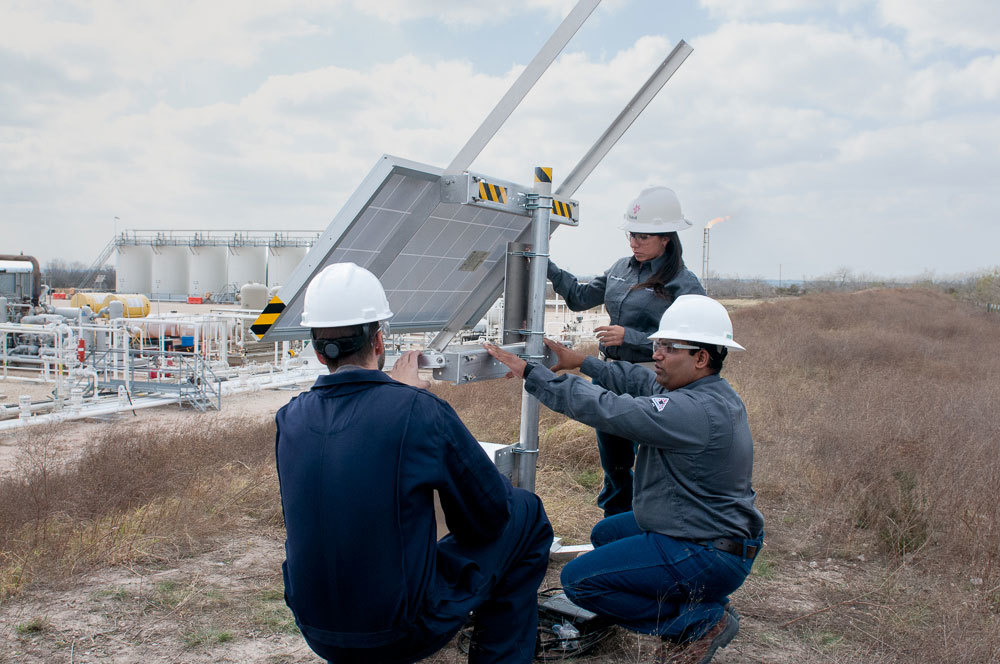
Dirk Richter (left), founder of Quanta3, inspects his company’s methane detection system at a Statoil well pad in Karnes County, Texas.
John Davidson / Environmental Defense Fund
Fiji George, the director of climate and sustainability at Cheniere Energy, the biggest LNG exporter in the US, says that if they become mature, commercially viable technologies, continuous monitoring solutions such as Rieker’s and Richter’s are the “holy grail” for the industry.
Both startups have ongoing field pilots with industry partners: LongPath, Rieker’s company, has field trials underway monitoring gas storage facilities in Colorado and California. Quanta3, Richter’s company, has partnered with big fossil fuel firms like Equinor (formerly Statoil) and Shell to test its systems in the Eagle Ford Shale formation in Texas and in Alberta, Canada, respectively. (The sensor in the Eagle Ford kept transmitting its automated updates throughout Hurricane Harvey in 2017.)
Many of the new detection offerings involve variations on laser absorption spectroscopy—an established technique that combines a laser source, mirrors, and detectors to measure the amount of light absorbed by a gas—all hooked up to software that translates that signal into a methane concentration number. Out of an office next to the tiny Boulder airport, Stephen Conley runs Scientific Aviation. He and a small team of aviator-scientists operate a fleet of small aircraft to provide emissions monitoring services to industry and regulators alike. A seasoned atmospheric scientist and a veteran pilot, Conley was the first person to detect and measure the biggest methane leak ever recorded in the US, which started at the Aliso Canyon natural gas storage facility in Southern California in October 2015.
Earlier this year, Conley rolled out a new service: drones mounted with lightweight laser-spectrometer sensors and air sampling canisters to monitor methane emissions much closer to their sources. While an airplane-mounted system like the one he flew thousands of feet above Aliso Canyon can find leaks as small as 10 kilograms per hour, his drones, he says, can detect much smaller ones, down to 10 grams per hour. Scientific Aviation has also chosen to make its designs and software open source. “We published our methodology, so anyone in the world can do this,” says Conley. “We’re not here just to make money. We’re here to reduce global methane emissions. We believe in the cause.”
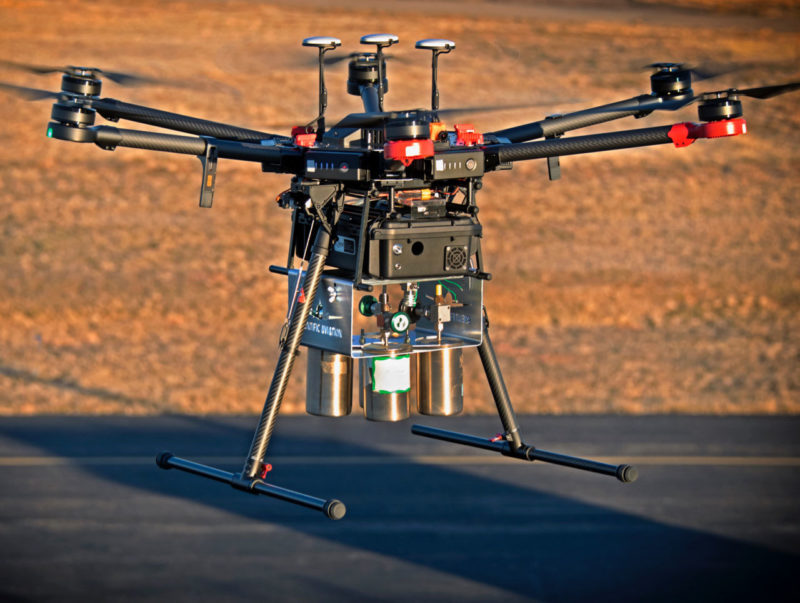
A drone equipped with laser-spectrometer sensors and air sampling canisters, developed by Scientific Aviation.
Scientific Aviation
Not all new solutions depend on laser spectroscopy, however. Ball Aerospace, headquartered in Broomfield, Colorado, has developed a LiDAR system for aerial, high-resolution mapping of leaks. Some other firms are pursuing solutions that adapt electrochemical sensors or handheld gas sensors used to detect alcohol levels in drivers to sniff out methane.
Most of these Colorado innovators test their technologies at the Methane Emissions Technology Evaluation Center (METEC), a facility on the outskirts of Fort Collins, funded by the US Department of Energy’s Advanced Research Projects Agency-Energy (ARPA-E) program. On the surface, the METEC facility looks just like the drilling sites out on County Road 28. But there is no oil or gas being pumped to the surface—only methane in carefully controlled releases from 200 different leak points. With the capacity to run demanding, complex simulations where visiting crews must hunt for multiple small leaks at a time, METEC is the only facility of its kind in the country. “I’m here to pour cold water on everything,” says Dan Zimmerle, the Colorado State University researcher who runs METEC.
METEC tests both stationary systems like Rieker’s as well as mobile ones, including aerial systems mounted on helicopters and, increasingly, drones. “There’s just been an explosion in the number of technologies and the range of systems you see,” says Arvind Ravikumar, an assistant professor of energy engineering at Harrisburg University who led an extensive field test study of different methane monitoring technologies at METEC last year.
This surge of invention “presents a huge opportunity to reduce emissions at lower cost and much faster than we used to before,” says Ravikumar. “If we’re going to reach net-zero emissions by 2050, our current practice of fossil fuel use cannot continue. But we have to strongly consider what’s doable with oil and gas—we’re not going to turn off all these pipes tomorrow. Every ton of methane and carbon dioxide reduced is an advantage in the long-term climate mitigation challenge.”
Yet industry experts say that without federal regulations to force operators to invest, there’s a limit to how much these ventures can grow. Shell, BP, ExxonMobil, and other fossil fuel companies issued a wave of press releases after both the EPA rollback in August and during United Nations’ climate meetings in New York in September, pledging to continue their voluntary efforts to cut methane emissions. But so far, these pledges haven’t translated into substantial investments in new methane leak technologies.
“Based on the press releases, I should have sold thousands of sensors,” Richter says. “They’re not backing it up…with investments of their own. I think federal regulation is still the required means to make them actually do something. When there is a rule that forces everybody to do the same thing—that’s when they will invest.”
If that investment materializes, the benefits could multiply even beyond the removal of super-warming pollutants from the atmosphere. With close to a million active wells around the US that will require ongoing monitoring, and 300,000 miles of interstate gas pipelines—not to mention thousands of compressor stations and over 100 liquefied natural gas facilities—methane detection using all these new tools could become a significant economic engine.
“These are jobs that would happen in west Texas, rural Colorado, rural Arkansas,” Ravikumar says. “It has the potential to bring in a lot of economic activity, with contractors out there on a regular basis and a whole host of support services that would need to come up in those regions.”
What’s more, scientists, entrepreneurs, and industry analysts see room for many different methane-sensing technologies to find a market. “This problem won’t be solved by any one technology,” Rieker says. “It’ll be a suite that covers the entire supply chain.” Drones are better for sniffing leaks along pipelines, whereas his laser is much better suited to monitoring a dense field of wells or a storage facility. “It’s a problem we can solve and we’ll all be a lot better off for it.”
